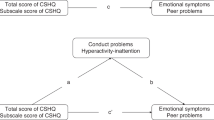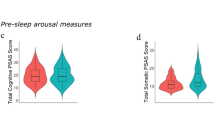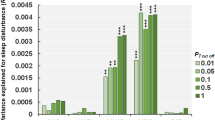Abstract
Background
This study aims to study prospectively specific sleep patterns and risk of ADHD after adjusting for potential confounders such as obstructive sleep apnoea (OSA) and methylphenidate use.
Methods
A population-representative sample of 514 Chinese preschool children was recruited when in kindergarten (K3). Parents reported on their socioeconomic status and children’s sleep duration. The cohort was reassessed 3 years later when the children were in Grade 3 (P3). Parents reported on children’s sleep patterns and ADHD symptoms. Information on OSA diagnosis and methylphenidate use was retrieved from health records.
Results
Among the 514 parent–child dyads (mean [SD] age, 5.52 [0.33] years), 411 were reassessed (80.0% retention; 9.35 [0.33] years) at follow-up. There were no significant baseline differences between follow-up and drop-out groups. A gradient relationship was observed between probable ADHD in P3 and sleep duration in K3. The risk of probable ADHD was 15.5 per 100 for children with <8 h of sleep in K3, whereas it was 1.1 per 100 for children with 11–12 h of sleep in K3. The adjusted risk ratio was 14.19 (p = 0.02).
Conclusions
Sleep deprivation in early childhood is associated with higher risk of ADHD in middle childhood.
Similar content being viewed by others
Log in or create a free account to read this content
Gain free access to this article, as well as selected content from this journal and more on nature.com
or
References
Man K. K. et al. ADHD drug prescribing trend is increasing among children and adolescents in Hong Kong. J. Atten. Disord. 21, 1161–1168 (2014).
Polanczyk, G. V., Willcutt, E. G., Salum, G. A., Kieling, C. & Rohde, L. A. ADHD prevalence estimates across three decades: an updated systematic review and meta-regression analysis. Int. J. Epidemiol. 43, 434–442 (2014).
Leung, P. W. et al. The diagnosis and prevalence of hyperactivity in Chinese schoolboys. Br. J. Psychiatry 168, 486–496 (1996).
Biederman, J. & Faraone, S. V. Attention-deficit hyperactivity disorder. Lancet 366, 237–248 (2005).
Touchette, E. et al. Associations between sleep duration patterns and behavioral/cognitive functioning at school entry. Sleep 30, 1213–1219 (2007).
Ficks, C. A. & Waldman, I. D. Gene-environment interactions in attention-deficit/hyperactivity disorder. Curr. Psychiatry Rep. 11, 387–392 (2009).
Garon, N., Bryson, S. E. & Smith, I. M. Executive function in preschoolers: a review using an integrative framework. Psychol. Bull. 134, 31 (2008).
Pauli-Pott, U. & Becker, K. Time windows matter in ADHD-related developing neuropsychological basic deficits: a comprehensive review and meta-regression analysis. Neurosci. Biobehav. Rev. 55, 165–172 (2015).
Tso, W. et al. Sleep duration and school readiness of Chinese children. J. Pediatr. 169, 266–271 (2016).
Corkum, P., Moldofsky, H., Hogg-Johnson, S., Humphries, T. & Tannock, R. Sleep problems in children with attention‐deficit/hyperactivity disorder: impact of subtype, comorbidity, and stimulant medication. J. Am. Acad. Child Adolesc. Psychiatry 38, 1285–1293 (1999).
Stein, M. A. Unravelling sleep problems in treated and untreated children with ADHD. J. Child Adolesc. Psychopharmacol. 9, 157–168 (1999).
Scott, N. et al. Sleep patterns in children with ADHD: a population-based cohort study from birth to 11 years. J. Sleep. Res. 22, 121–128 (2013).
O’Brien, L. M. & Gozal, D. Behavioural and neurocognitive implications of snoring and obstructive sleep apnoea in children: facts and theory. Paediatr. Respir. Rev. 3, 3–9 (2002).
Tirosh, E., Sadeh, A., Munvez, R. & Lavie, P. Effects of methylphenidate on sleep in children with attention-deficit hyperactivity disorder: an activity monitor study. Am. J. Dis. Child. 147, 1313–1315 (1993).
Arnett, A. B., Pennington, B. F., Willcutt, E. G., DeFries, J. C. & Olson, R. K. Sex differences in ADHD symptom severity. J. Child Psychol. Psychiatry 56, 632–639 (2015).
Ip, P. et al. Socioeconomic gradients in school readiness of Chinese preschool children: the mediating role of family processes and kindergarten quality. Early Child. Res. Q. 35, 111–123 (2016).
U.S. National Institutes of Health. Your Guide to Healthy Sleep (National Institutes of Health, Bethesda, Maryland, 2011).
Li, A. M. et al. Validation of a questionnaire instrument for prediction of obstructive sleep apnea in Hong Kong Chinese children. Pediatr. Pulmonol. 41, 1153–1160 (2006).
Liu, X., Liu, L., Owens, J. A. & Kaplan, D. L. Sleep patterns and sleep problems among school children in the United States and China. Pediatrics 115, (Supplement 1), 241–249 (2005).
Swanson, J. M. et al. Categorical and dimensional definitions and evaluations of symptoms of ADHD: history of the SNAP and the SWAN rating scales. Int. J. Educ. Psychol. Assess. 10, 51 (2012).
Lai, K. Y. et al. Validation of the Chinese strengths and weaknesses of ADHD-symptoms and normal-behaviors questionnaire in Hong Kong. J. Atten. Disord. 17, 194–202 (2013).
Ip, P. et al. Validation study of the Chinese early development instrument (CEDI). BMC Pediatr. 13, 1 (2013).
Zou, G. A modified poisson regression approach to prospective studies with binary data. Am. J. Epidemiol. 159, 702–706 (2004).
Youssef, N. A., Ege, M., Angly, S. S., Strauss, J. L. & Marx, C. E. Is obstructive sleep apnea associated with ADHD? Ann. Clin. Psychiatry 23, 213–224 (2011).
do Lago Godoi, F. R., Oliveira, M. G. M. & Tufik, S. Effects of paradoxical sleep deprivation on the performance of rats in a model of visual attention. Behav. Brain Res. 165, 138–145 (2005).
Córdova, C. A. et al. Sleep deprivation in rats produces attentional impairments on a 5-choice serial reaction time task. Sleep 29, 69 (2006).
Willie, J. T., Sinton, C. M., Maratos-Flier, E. & Yanagisawa, M. Abnormal response of melanin-concentrating hormone deficient mice to fasting: hyperactivity and rapid eye movement sleep suppression. Neuroscience 156, 819–829 (2008).
Solanto, M. V. Dopamine dysfunction in AD/HD: integrating clinical and basic neuroscience research. Behav. Brain Res. 130, 65–71 (2002).
Volkow, N. D. et al. Sleep deprivation decreases binding of [11C] raclopride to dopamine D2/D3 receptors in the human brain. J. Neurosci. 28, 8454–8461 (2008).
Koenis, M. M. et al. Does sleep restore the topology of functional brain networks? Hum. Brain Mapp. 34, 487–500 (2013).
Hall, M. et al. Psychological stress is associated with heightened physiological arousal during NREM sleep in primary insomnia. Behav. Sleep Med. 5, 178–193 (2007).
Catala-Lopez, F. et al. Prevalence of attention deficit hyperactivity disorder among children and adolescents in Spain: a systematic review and meta-analysis of epidemiological studies. BMC Psychiatry 12, 168 (2012).
Nussbaum, N. L. ADHD and female specific concerns: a review of the literature and clinical implications. J. Atten. Disord. 16, 87–100 (2012).
Valera, E. M. et al. Sex differences in the functional neuroanatomy of working memory in adults with ADHD. Am. J. Psychiatry 167, 86–94 (2010).
Barry, R. J., Clarke, A. R., McCarthy, R. & Selikowitz, M. Age and gender effects in EEG coherence: III. Girls with attention-deficit/hyperactivity disorder. Clin. Neurophysiol. 117, 243–251 (2006).
Hermens, D. F., Kohn, M. R., Clarke, S. D., Gordon, E. & Williams, L. M. Sex differences in adolescent ADHD: findings from concurrent EEG and EDA. Clin. Neurophysiol. 116, 1455–1463 (2005).
Romero-Martinez, A., Polderman, T. J., Gonzalez-Bono, E. & Moya-Albiol, L. Masculinization in parents of offspring with autism spectrum disorders could be involved in comorbid ADHD symptoms. J. Atten. Disord. 21, 938–943 (2017).
Rice, D. & Barone, S. Jr. Critical periods of vulnerability for the developing nervous system: evidence from humans and animal models. Environ. Health Perspect. 108, (Suppl 3), 511–533 (2000).
Brown, E. D. & Ackerman, B. P. Contextual risk, maternal negative emotionality, and the negative emotion dysregulation of preschool children from economically disadvantaged families. Early Educ. Dev. 22, 931–944 (2011).
Boles, R. E. et al. Family chaos and child functioning in relation to sleep problems among children at risk for obesity. Behav. Sleep Med. 15, 114–128 (2017).
Harvey, A. G., Murray, G., Chandler, R. A. & Soehner, A. Sleep disturbance as transdiagnostic: consideration of neurobiological mechanisms. Clin. Psychol. Rev. 31, 225–235 (2011).
Faruqui, F., Khubchandani, J., Price, J. H., Bolyard, D. & Reddy, R. Sleep disorders in children: a national assessment of primary care pediatrician practices and perceptions. Pediatrics 128, 539–546 (2011).
Sadeh, A. A brief screening questionnaire for infant sleep problems: validation and findings for an Internet sample. Pediatrics 113, e570–e577 (2004).
Wing, Y. K. et al. A school-based sleep education program for adolescents: a cluster randomized trial. Pediatrics 135, e635–e643 (2015).
Acknowledgments
We thank the schools, children, and their parents for participating in this study. The cohort study was fully supported by two research grants from the Research Grants Council of the Hong Kong Special Administrative Region, China (Project Nos. 743413 and 746111).
Author contributions
W.T. interpreted the data and wrote the first draft of the manuscript. F.K.W.H. analysed the data, drafted a part of the manuscript, and critically revised the manuscript. M.C., K.L.C., A.M.L., A.T., Y.K.W., I.C.K.W., B.V.V., S.L.L. and W.H.S.G. interpreted the data and critically revised the manuscript. P.I. and N.R. conceptualised and designed the study, interpreted the data, and critically revised the manuscript. All authors have read and approved the final version of the manuscript.
Funding disclosure
The cohort study was supported by two research grants from the Research Grants Council of the Hong Kong Special Administrative Region, China (Project Nos. 743413 and 746111). The funder has no role in (1) study design; (2) the collection, analysis, and interpretation of data; (3) the writing of the report; and (4) the decision to submit the paper for publication.
Author information
Authors and Affiliations
Corresponding authors
Ethics declarations
Competing interests
The authors declare no competing interests.
Additional information
Publisher’s note: Springer Nature remains neutral with regard to jurisdictional claims in published maps and institutional affiliations.
Co-first authors: Winnie Tso, Meanne Chan.
Rights and permissions
About this article
Cite this article
Tso, W., Chan, M., Ho, F.K. et al. Early sleep deprivation and attention-deficit/hyperactivity disorder. Pediatr Res 85, 449–455 (2019). https://doi.org/10.1038/s41390-019-0280-4
Received:
Revised:
Accepted:
Published:
Issue date:
DOI: https://doi.org/10.1038/s41390-019-0280-4
This article is cited by
-
Gut microbial genetic variation modulates host lifespan, sleep, and motor performance
The ISME Journal (2023)
-
Comorbidity of ADHD and allergic diseases in early adolescence: The role of parental smoking at home
Current Psychology (2023)
-
Exploring the role of family communication time in the association between family dinner frequency and adolescent psychological distress
Current Psychology (2023)
-
Vulnerability and resilience in children during the COVID-19 pandemic
European Child & Adolescent Psychiatry (2022)
-
Treatment with Methylphenidate for Attention Deficit Hyperactivity Disorder (ADHD) and the Risk of All-Cause Poisoning in Children and Adolescents: A Self-Controlled Case Series Study
CNS Drugs (2021)



